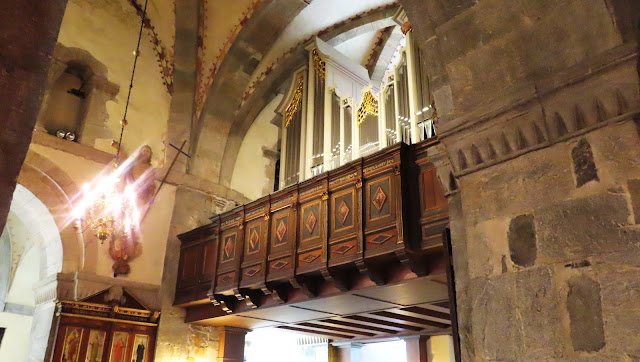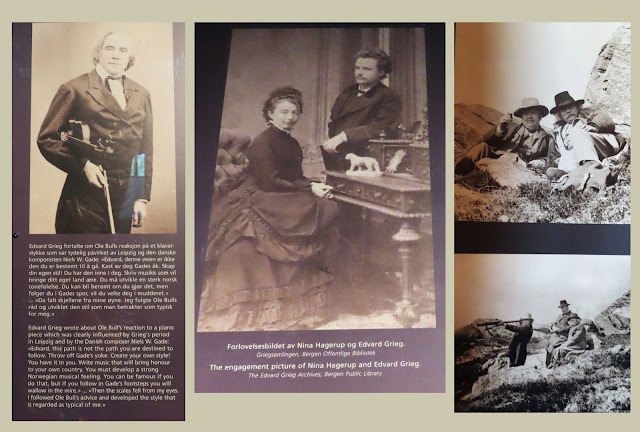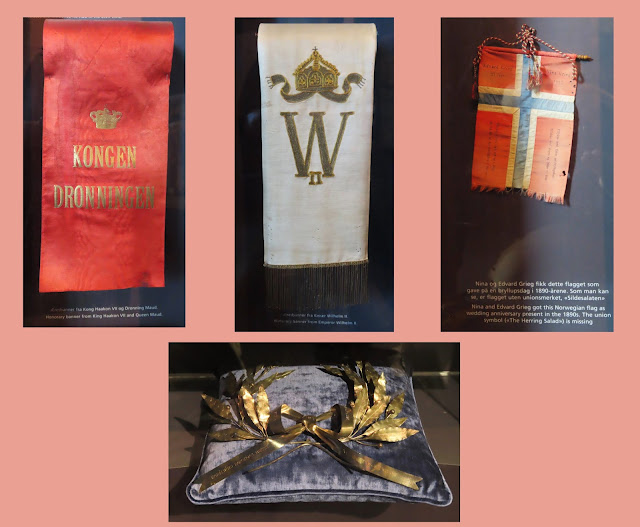The Last Days of a Wonderful Tour
June 16 and 17 in Bergen
June 16 - The Last Day of our Tour
 |
| The view of Bergen from the top of Fløyen mountain |
Today was day filled with nostalgia as I wandered around the streets of my old home. Bergen has grown tremendously since 1970, stretching further into the hills behind, but the old harbor area is very much the same, with the old Hanseatic League buildings leaning crookedly against each other along Bryggen (the wharf), the old Fish Market still selling salted cod, salmon, various shellfish, and sausages, (and still selling whale meat, which annoys me.)
Mount Fløyen
Our group started the morning with
a ride on the Fløibanen, the funicular that transports both visitors and locals to the top of Fløyen mountain with its iconic views of Bergen, the fjords, and the surrounding countryside. This was a favorite spot with us students, as there are a lot of hiking trails into the hills. The cute little herd of goats that lives here is new. They help keep the vegetation on the hill under control.
 |
| Views of the growing city from Fløyen mountain |
 |
| The Fløybanen, the funicular to the top of the mountain |
 |
| Looking down the tracks of the funicular |
 |
| Friendly goats enjoying the warm sunshine |
 |
| Valdemar, a groundskeeping goat |
 |
| Leave it to Norway to have a solar-powered trash can |
 |
| A playground at the top of the mountain |
Our Bergen Tour - The Harbor
After a little break, we met by the harbor for a walking tour, led by Sue, an English ex-pat who married a Norwegian and has lived here for years. As always, I learned some new things, but she took quite a long time behind the old buildings of Bryggen, then got a bit rushed in the newer parts of the town.
 |
| One branch of the large Bergen Harbor |
 |
| Our guide, Sue, shares the history of Bergen |
The Dramshusen Shed and hoisting boom is part of the Hanseatic Museum complex. The shed was used as a storage place for goods waiting to be transferred to the warehouses. Throughout the era of the Norwegian Office (1754-1867), merchants established a joint pricing mechanism called the Kuranten. It stipulated minimum and maximum prices for goods. Every year, the prices would be set during a meeting in the Dramshusen Shed. Thus, this modest shed became Bergen's first Stock Exchange. The current shed was built in 1900 and is a replica of the original.
 |
| A photo of Bergens' busy harbor in earlier years. |
The Bryggen
We walked all over the harbor area, starting with the buildings of the Bryggen, the UNESCO World Heritage site of the old harbor area of Bergen. This was the Norwegian port of the Hanseatic League, a major trading empire from the 14th through the 16th century. In spite of many fires, age, and flood, there are still 62 of the buildings left standing (or leaning against the others for support.)
The building store fronts are filled with modern merchandise, souvenirs, and Norse woolens, but Sue walked us through the narrow back alleys, giving us information about the historical importance of this area.
 |
Sue leads us through the narrow alleys between the leaning buildings.
|
 |
| There were more old buildings tucked behind the tall buildings along the harbor. |
 |
The gables sticking out of the buildings had
hooks and chains for raising goods into the warehouses. |
 |
| Inside the Hanseatic Museum was a model of the old city. |
 |
| A preserved portion of the stone herringbone floor |
 |
| An ancient iron door |
 |
| Behind the Bryggen |
Neighborhoods of Bergen - Old and New
We moved on past slightly more modern buildings - 18th and 19th century - then moved on to the district of Vågsbunnen, where some of the buildings date back to medieval Bergen. Sue told us stories about some of the people who had lived there, but unfortunately, I have forgotten her stories.
 |
| This oldest pub in Bergen dates back to the 1300s! |
 |
Remember walking through the narrowest street in Stockholm?
Here is the narrowest street in Bergen. |
t.
Our next stop was the modern town square with its large lake and fountain. After admiring the gazebo and statue of Edvard Grieg in the park, we walked up Ole Bull Plass to see the statue of Ole Bull, an important Norwegian violinist and composer, and the Bergen National Theater at the top of the street.After the tour, Bruce and I went for lunch at a small stand that sells reindyr pølse, reindeer sausage hotdogs, with lingonberry sauce and crispy fried onions. Delicious!
St. Mary's Church
In the late afternoon, I headed by myself to St. Mary's Church, built sometime in the 1100s and the oldest existing building in Bergen. Somehow, I had never visited this church before. Looking back at my student years, I wonder what I was thinking! I was so busy with friends and studies that I really never bothered to dig deep into Bergen to seek out gems like this. The church was gorgeous, with one of the most amazing carved wooden pulpits I have ever seen.
The rest of the afternoon, I just browsed around the town. Haakon's Hall and the Rosencrantz Tower, the two medieval stone buildings at the far end of Bryggen, were two of the sites of a big music festival that was going on, so I avoided the huge crowds there and instead checked out the big modern mall back on Torgallmenningen. The mall is in an old building, but the interior was modern and bright - filled with escalators leading to several floors of stores of clothing, shoes, etc. just like any modern mall.
 |
| Haakon's Hall, with Rosecrantz Tower hiding to the right |
 |
| Inside a modern mall in Bergen |
Farewell Dinner
The day ended with our tour's Farewell Dinner held in one of the ancient buildings of Bryggen. It was fun and lively, with lots of toasting and lots of hugs as we said good-bye to new friends. Laurel, our guide for the entire trip, handed out little gifts to everyone. This really was a lovely group and I am sure some of us will stay in touch after the tour.
June 17 - One Final Day in Bergen
This morning started with goodbyes to many of my fellow travelers, but I stayed on for one more day to see a few more sights in my old
university town. Linda S. was also staying an extra day, so she and I joined up to explore the countryside outside of the city. We took the tram out to Troldhaugen, the home of one of my favorite composers, Edvard Grieg. When I lived here fifty-three years ago, I used to walk by his house every day of my first month here. (The new dorms were not quite ready, so I was housed with a family here for a month, living in a little attic room.) And when I walked past Troldhaugen, his property contained only the cute Victorian style house and the little hytta (hut) below by the fjord where he sat and wrote his music. Now the house sits beside a museum and concert hall and is visited by hundreds of people every day.
 |
| Joan and Linda on the Tram to Troldhaugen |
 |
| Bergen has a great tram system. (I used to have to take a bus to the dorm.) |
 |
| The signs were helpful once we arrived, but we were glad to have our phones with GPS! |
 |
| It was a lovely walk from the tram to Troldhaugen |
Linda and I arrived just in time to get tickets to the next piano concert by a talented young pianist named Emil Duncumb. The sunken concert hall is called Troldsalon. It is a sunken concert hall with a sod roof, known for it's good acoustics.
 |
Troldsalon, the Concert Hall at Troldhaugen, was built in 1985 -
100 years after Grieg moved here. |
 |
| The grass-covered room of the concert hall. |
We followed the concert with a tour of the inside of the house and museum. The tours were both excellent. The house, where he lived with his wife Nina, was filled with his furniture and artwork, as well as photos and mementos from his life.
Grieg's House and Hytta
 |
| A statue of Grieg stands on the grounds |
 |
| Joan and Linda above Grieg's hut by the fjord |
 |
| Grieg composed much of his music in this hytta. |
 |
| Inside the hytta - Grieg's piano and simple furnishings |
 |
| The gorgous views from the hytta must have inspired him. |
Grieg's House
 |
| Original furniture from the late 1800s |
 |
| Grieg's Steinway piano |
Grieg's house was not the only thing that has changed over the decades. I could not figure out how to walk from the museum to the house I had once lived in because a big freeway now stands between Grieg's house and that house.
As we returned on the tram, I got a quick glimpse of my old dorm in Fantoft, the small community near Troldhaugen. When I lived here, the building was brand-new and stood in an empty field. It is now surrounded by shops and other buildings. Life certainly marches on, doesn't it?
 |
| I lived on one of the upper floors of this tall dormitory. |
 |
| This plaza used to be a dirt field where we would make "snow angels" in the winter snow. |
The rest of the afternoon was spent packing and moving to the Clarion Hotel at the Bergen Airport in preparation for my 6:00 a.m. flight the next morning. So bright and early on Sunday (and yes, 3:30 a.m. was pretty light already in these northern climes), I walked into the terminal and headed home with a head filled with great memories.
Thanks for following along on the adventure!

























































































.jpeg)





























